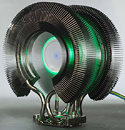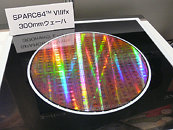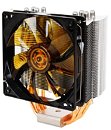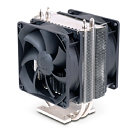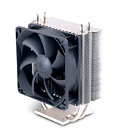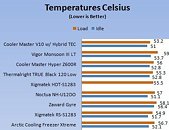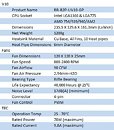Sharkoon Announces Silent Eagle C92 and C120 CPU Cooler
Sharkoon introduces two all new high-performance, and quiet, Tower-coolers for the AMD- and Intel-processors. The Sharkoon Silent Eagle CPU cooler options are the Model C92 with a 92mm fan and Model C120 with a 120mm fan. Both provide four U-equalizing 8mm cooling heat pipes and premium aluminium fins for efficient heat dissipation. This is further strengthened by the Direct-Touch-Technology: The heat pipes rest directly on the processor, so that the heat is released directly without having to detour through an extra plate to the cooling fans.
Sharkoon's popular Silent Eagle models utilize an innovative Golf ball surface texture application. The round dimples on the rotor blades minimize air turbulence and provides a boost in air output at the same rotational speed and noise emission. The fans are equipped with a 4-pin PMW connector to automatically regulate over the provided mainboard. The 92mm fan of the C92 model rotates between 350 to 1600 r/min, with a maximum sound volume of 24,8 dB(A) and motion air flow up to 72,9 m³/h. The heat sink, including fan, measures 120 x 92 x 77 mm (H x W x D) and weighs 550 g. The 120mm fan of the larger C120 model rotates between 359 to 1200 r/min and conveys a sound volume under full load of 20 dB(A) with a motion air flow of 83 m³/h. The C120 measures 157 x 125 x 86 (H x W x D) and weighs 755 g.
Sharkoon's popular Silent Eagle models utilize an innovative Golf ball surface texture application. The round dimples on the rotor blades minimize air turbulence and provides a boost in air output at the same rotational speed and noise emission. The fans are equipped with a 4-pin PMW connector to automatically regulate over the provided mainboard. The 92mm fan of the C92 model rotates between 350 to 1600 r/min, with a maximum sound volume of 24,8 dB(A) and motion air flow up to 72,9 m³/h. The heat sink, including fan, measures 120 x 92 x 77 mm (H x W x D) and weighs 550 g. The 120mm fan of the larger C120 model rotates between 359 to 1200 r/min and conveys a sound volume under full load of 20 dB(A) with a motion air flow of 83 m³/h. The C120 measures 157 x 125 x 86 (H x W x D) and weighs 755 g.







